

Compact Muon Solenoid
LHC, CERN
| CMS-HIG-16-016 ; CERN-EP-2016-249 | ||
| Searches for invisible decays of the Higgs boson in pp collisions at $\sqrt{s}= $ 7, 8, and 13 TeV | ||
| CMS Collaboration | ||
| 28 October 2016 | ||
| JHEP 02 (2017) 135 | ||
| Abstract: Searches for invisible decays of the Higgs boson are presented. The data collected with the CMS detector at the LHC correspond to integrated luminosities of 5.1, 19.7, and 2.3 fb$^{-1}$ at centre-of-mass energies of 7, 8, and 13 TeV, respectively. The search channels target Higgs boson production via gluon fusion, vector boson fusion, and in association with a vector boson. Upper limits are placed on the branching fraction of the Higgs boson decay to invisible particles, as a function of the assumed production cross sections. The combination of all channels, assuming standard model production, yields an observed (expected) upper limit on the invisible branching fraction of 0.24 (0.23) at the 95% confidence level. The results are also interpreted in the context of Higgs-portal dark matter models. | ||
| Links: e-print arXiv:1610.09218 [hep-ex] (PDF) ; CDS record ; inSPIRE record ; HepData record ; CADI line (restricted) ; | ||
| Figures | |

png pdf |
Figure 1:
Feynman diagrams for the three production processes targeted in the search for invisible Higgs boson decays: (upper left) $\mathrm{ q } \mathrm{ q } \to \mathrm{ q } \mathrm{ q } \mathrm{ H } $, (upper right) $ {\mathrm{ q } \mathrm{ \bar{q} } } \to \mathrm {V}\mathrm{ H } $, and (bottom) $\mathrm{g} \mathrm{g} \to \mathrm{g} \mathrm{ H } $. |

png pdf |
Figure 1-a:
Feynman diagram for one of the three production processes targeted in the search for invisible Higgs boson decays: $\mathrm{ q } \mathrm{ q } \to \mathrm{ q } \mathrm{ q } \mathrm{ H } $. |
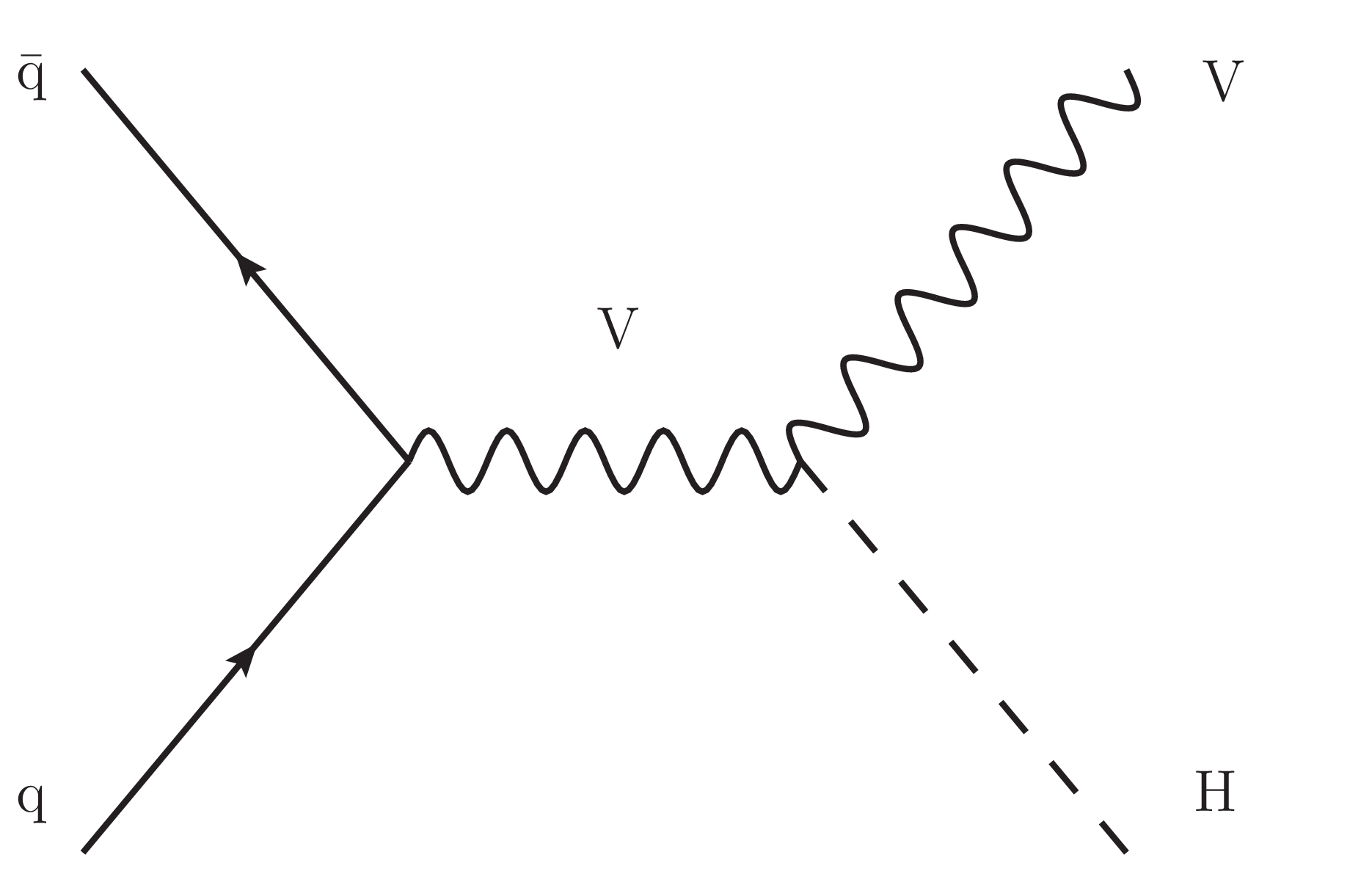
png pdf |
Figure 1-b:
Feynman diagram for one of the three production processes targeted in the search for invisible Higgs boson decays: $ {\mathrm{ q } \mathrm{ \bar{q} } } \to \mathrm {V}\mathrm{ H } $. |

png pdf |
Figure 1-c:
Feynman diagram for one of the three production processes targeted in the search for invisible Higgs boson decays: $\mathrm{g} \mathrm{g} \to \mathrm{g} \mathrm{ H } $. |

png pdf |
Figure 2:
Feynman diagrams for the $\mathrm{ gg \to ZH}$ production processes involving a coupling between (left) the top quark and the Higgs boson or (right) the Z and Higgs bosons. |
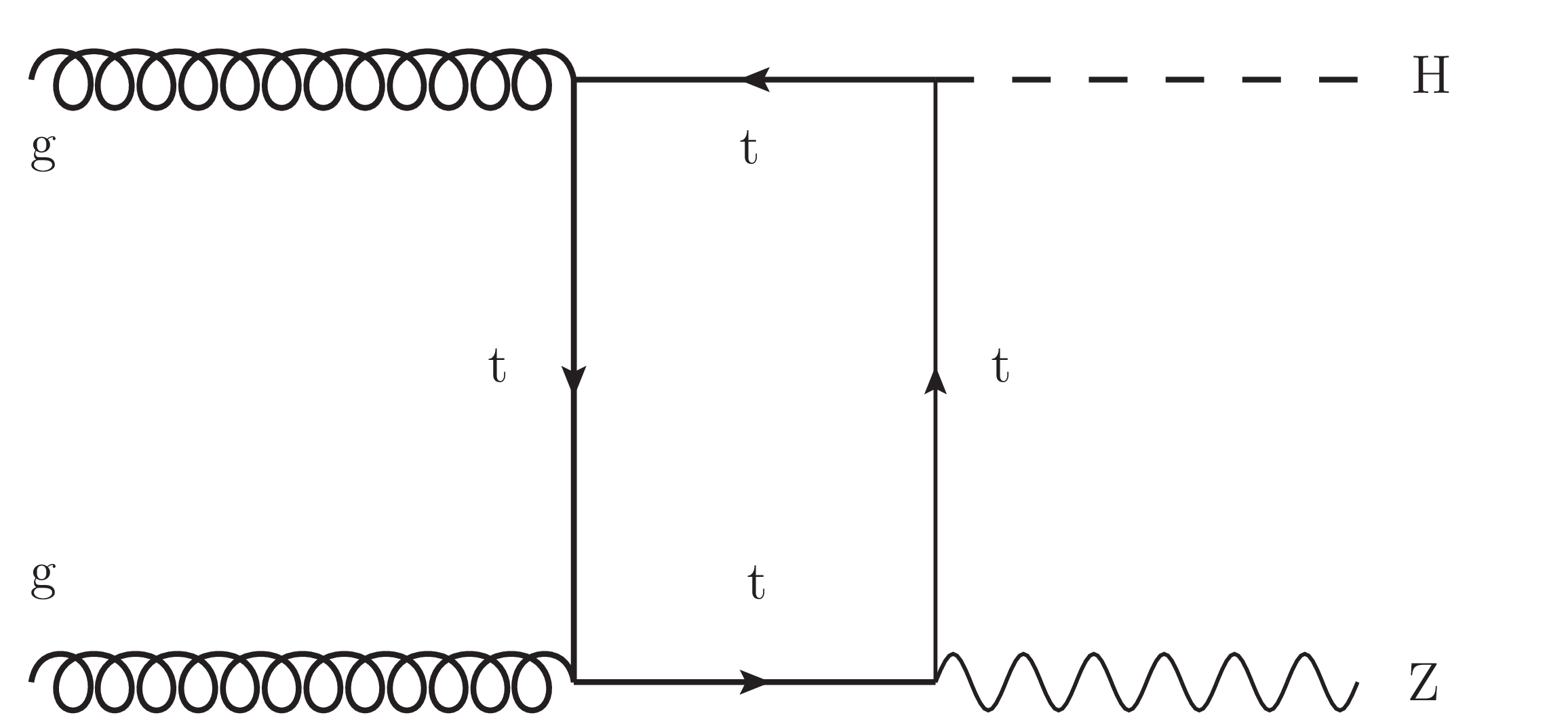
png pdf |
Figure 2-a:
Feynman diagram for the $\mathrm{ gg \to ZH}$ production process involving a coupling between the top quark and the Higgs boson. |
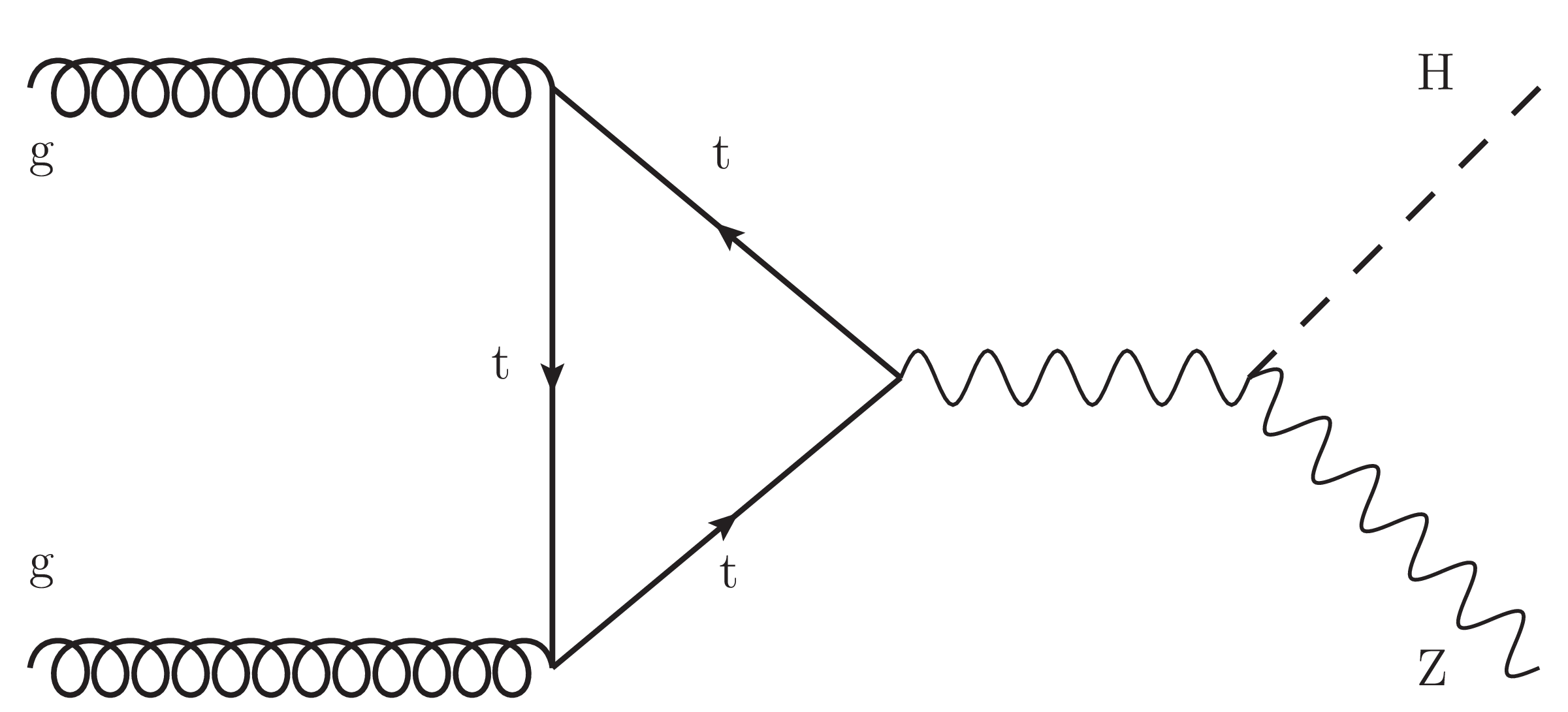
png pdf |
Figure 2-b:
Feynman diagram for the $\mathrm{ gg \to ZH}$ production process involving a coupling between the Z and Higgs bosons. |

png pdf |
Figure 3:
Distributions of (left) $ {{\Delta \eta (\mathrm {j_{1},j_{2}})}}$ and (right) $ {m_{\mathrm {jj}}}$ in events selected in the VBF analysis for data and simulation at 13 TeV. The background yields are scaled to their post-fit values, with the total post-fit uncertainty represented as the black hatched area. The last bin contains the overflow events. The expected contribution from a Higgs boson with a mass of 125 GeV, produced with the SM cross section and decaying to invisible particles with 100% branching fraction, is overlaid. |

png pdf |
Figure 3-a:
Distribution of $ {{\Delta \eta (\mathrm {j_{1},j_{2}})}}$ in events selected in the VBF analysis for data and simulation at 13 TeV. The background yields are scaled to their post-fit values, with the total post-fit uncertainty represented as the black hatched area. The last bin contains the overflow events. The expected contribution from a Higgs boson with a mass of 125 GeV, produced with the SM cross section and decaying to invisible particles with 100% branching fraction, is overlaid. |
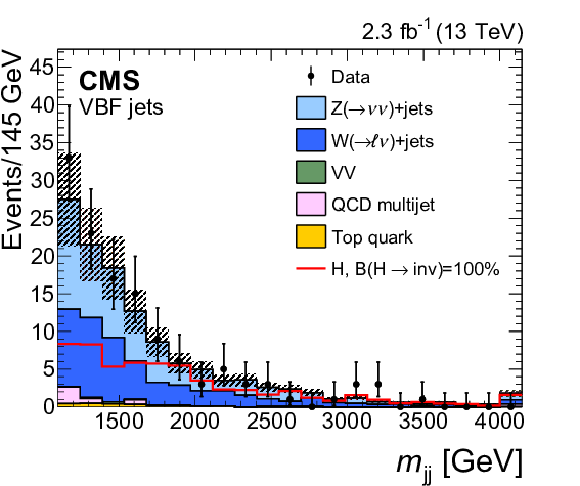
png pdf |
Figure 3-b:
Distribution of $ {m_{\mathrm {jj}}}$ in events selected in the VBF analysis for data and simulation at 13 TeV. The background yields are scaled to their post-fit values, with the total post-fit uncertainty represented as the black hatched area. The last bin contains the overflow events. The expected contribution from a Higgs boson with a mass of 125 GeV, produced with the SM cross section and decaying to invisible particles with 100% branching fraction, is overlaid. |

png pdf |
Figure 4:
Distributions of $ {m_{\mathrm {T}}}$ in data and simulation for events in the (left) 0-jet and (right) 1-jet categories of the $ {{\mathrm{ Z } } (\ell ^+\ell ^-)}$ analysis at 13 TeV, combining dielectron and dimuon events. The background yields are normalised to 2.3 fb$^{-1}$. The shaded bands represent the total statistical and systematic uncertainties in the backgrounds. The horizontal bars on the data points represent the width of the bin centred at that point. The expectation from a Higgs boson with a mass of 125 GeV, from ZH production, decaying to invisible particles with a 100% branching fraction is shown in red. |

png pdf |
Figure 4-a:
Distribution of $ {m_{\mathrm {T}}}$ in data and simulation for events in the 0-jetcategory of the $ {{\mathrm{ Z } } (\ell ^+\ell ^-)}$ analysis at 13 TeV, combining dielectron and dimuon events. The background yields are normalised to 2.3 fb$^{-1}$. The shaded band represents the total statistical and systematic uncertainties in the backgrounds. The horizontal bars on the data points represent the width of the bin centred at that point. The expectation from a Higgs boson with a mass of 125 GeV, from ZH production, decaying to invisible particles with a 100% branching fraction is shown in red. |
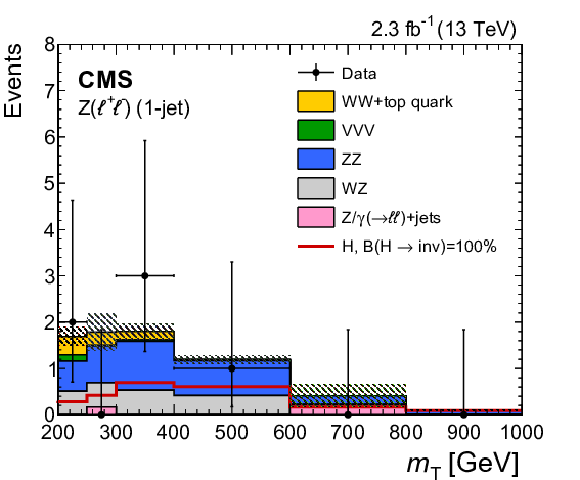
png pdf |
Figure 4-b:
Distribution of $ {m_{\mathrm {T}}}$ in data and simulation for events in the 1-jet category of the $ {{\mathrm{ Z } } (\ell ^+\ell ^-)}$ analysis at 13 TeV, combining dielectron and dimuon events. The background yields are normalised to 2.3 fb$^{-1}$. The shaded band represents the total statistical and systematic uncertainties in the backgrounds. The horizontal bars on the data points represent the width of the bin centred at that point. The expectation from a Higgs boson with a mass of 125 GeV, from ZH production, decaying to invisible particles with a 100% branching fraction is shown in red. |
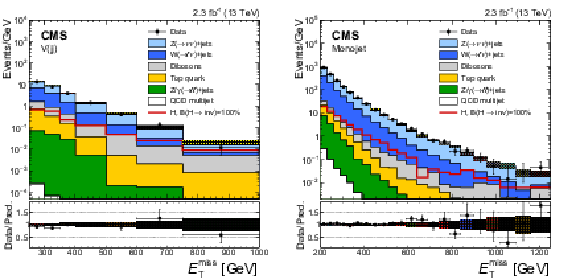
png pdf |
Figure 5:
Distributions of $ {E_{\mathrm {T}}^{\text {miss}}} $ in data and predicted background contributions in the (left) $ {\textrm {V}(\mathrm {jj})}$ and (right) monojet channels at 13 TeV. The background prediction is taken from a fit using only the control regions and the shaded bands represent the statistical and systematic uncertainties in the backgrounds after that fit. The horizontal bars on the data points represent the width of the bin centred at that point. The expectations from a Higgs boson with a mass of 125 GeV decaying to invisible particles with a branching fraction of 100% are superimposed. |
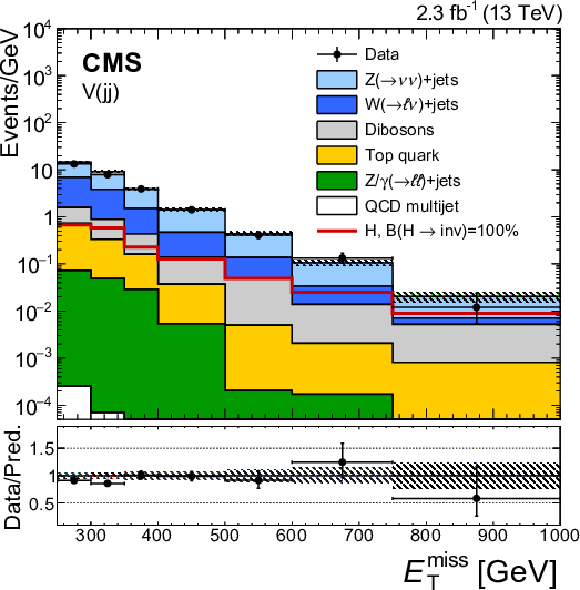
png pdf |
Figure 5-a:
Distribution of $ {E_{\mathrm {T}}^{\text {miss}}} $ in data and predicted background contributions in the $ {\textrm {V}(\mathrm {jj})}$ channel at 13 TeV. The background prediction is taken from a fit using only the control regions and the shaded bands represent the statistical and systematic uncertainties in the backgrounds after that fit. The horizontal bars on the data points represent the width of the bin centred at that point. The expectations from a Higgs boson with a mass of 125 GeV decaying to invisible particles with a branching fraction of 100% are superimposed. |

png pdf |
Figure 5-b:
Distribution of $ {E_{\mathrm {T}}^{\text {miss}}} $ in data and predicted background contributions in the monojet channel at 13 TeV. The background prediction is taken from a fit using only the control regions and the shaded bands represent the statistical and systematic uncertainties in the backgrounds after that fit. The horizontal bars on the data points represent the width of the bin centred at that point. The expectations from a Higgs boson with a mass of 125 GeV decaying to invisible particles with a branching fraction of 100% are superimposed. |
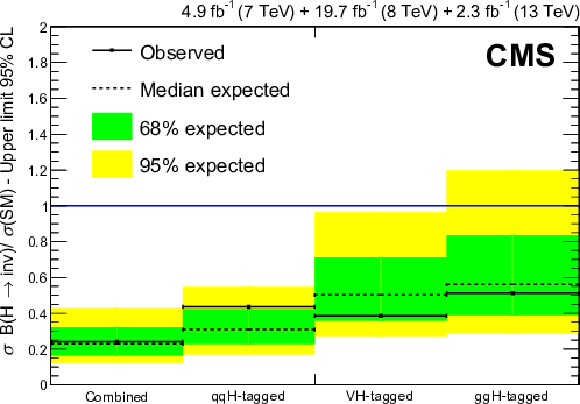
png pdf |
Figure 6:
Observed and expected 95% CL limits on $ {\sigma {\mathcal {B}(\mathrm{ H } \to \text {inv})} /\sigma (\mathrm {SM})} $ for individual combinations of categories targeting qqH, VH, and ggH production, and the full combination assuming a Higgs boson with a mass of 125 GeV. |
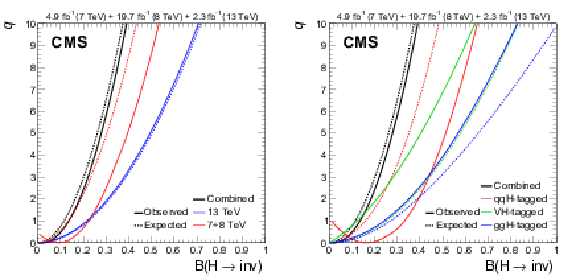
png pdf |
Figure 7:
Profile likelihood ratio as a function of ${\mathcal {B}(\mathrm{ H } \to \text {inv})}$ assuming SM production cross sections of a Higgs boson with a mass of 125 GeV. The solid curves represent the observations in data and the dashed curves represent the expected result assuming no invisible decays of the Higgs boson. (left) The observed and expected likelihood scans for the partial combinations of the 7+8 and 13 TeV analyses, and the full combination. (right) The observed and expected likelihood scans for the partial combinations of the qqH-tagged, VH-tagged, and ggH-tagged analyses, and the full combination. |

png pdf |
Figure 7-a:
Profile likelihood ratio as a function of ${\mathcal {B}(\mathrm{ H } \to \text {inv})}$ assuming SM production cross sections of a Higgs boson with a mass of 125 GeV. The solid curves represent the observations in data and the dashed curves represent the expected result assuming no invisible decays of the Higgs boson. The observed and expected likelihood scans for the partial combinations of the 7+8 and 13 TeV analyses, and the full combination. |
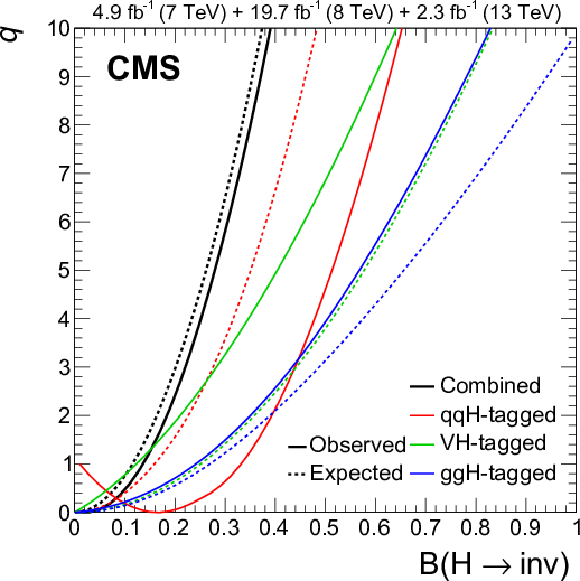
png pdf |
Figure 7-b:
Profile likelihood ratio as a function of ${\mathcal {B}(\mathrm{ H } \to \text {inv})}$ assuming SM production cross sections of a Higgs boson with a mass of 125 GeV. The solid curves represent the observations in data and the dashed curves represent the expected result assuming no invisible decays of the Higgs boson. The observed and expected likelihood scans for the partial combinations of the qqH-tagged, VH-tagged, and ggH-tagged analyses, and the full combination. |
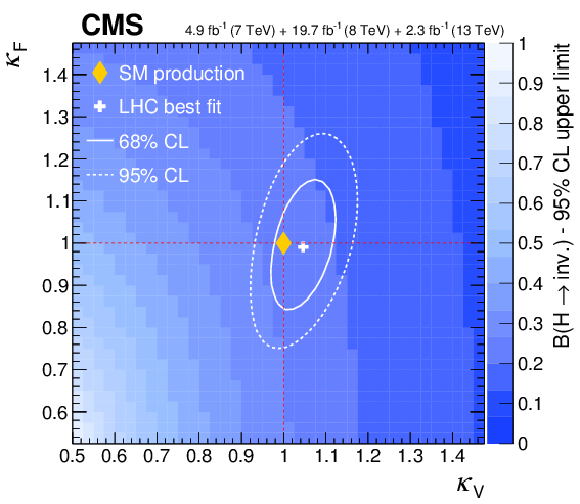
png pdf |
Figure 8:
Observed 95% CL upper limits on ${\mathcal {B}(\mathrm{ H } \to \text {inv})}$ assuming a Higgs boson with a mass of 125 GeV whose production cross sections are scaled, relative to their SM values as a function of the coupling modifiers $\kappa _{F}$ and $\kappa _{V}$. The best-fit, and 68 and 95% confidence level regions for $\kappa _{F}$ and $\kappa _{V}$ from Ref. [4] are superimposed as the solid and dashed white contours, respectively. The SM prediction (yellow diamond) corresponds to $\kappa _{F}=\kappa _{V}=$ 1. |

png pdf |
Figure 9:
Limits on the spin-independent DM-nucleon scattering cross section in Higgs-portal models assuming a scalar or fermion DM particle. The dashed lines show the variation in the exclusion limit using alternative values for $f_{\mathrm {N}}$ as described in the text. The limits are given at the 90% CL to allow for comparison to direct detection constraints from the LUX [94], PandaX-II [95], and CDMSlite [96] experiments. |
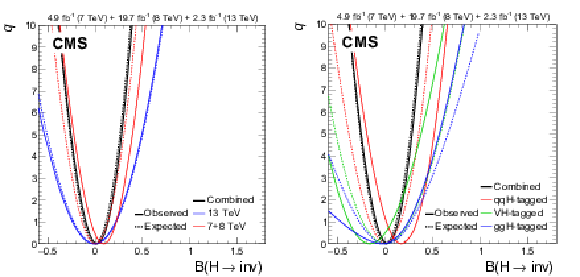
png pdf |
Figure 10:
Profile likelihood ratio as a function of ${\mathcal {B}(\mathrm{ H } \to \text {inv})}$ assuming SM production cross sections of a Higgs boson with a mass of 125 GeV. The solid curves represent the observations in data and the dashed curves represent the expected result assuming no invisible decays of the Higgs boson. (left) The observed and expected likelihood scans for the partial combinations of the 7+8 and 13 TeV analyses, and the full combination. (right) The observed and expected likelihood scans for the partial combinations of the VBF-tagged, VH-tagged, and ggH-tagged analyses, and the full combination. |

png pdf |
Figure 10-a:
Profile likelihood ratio as a function of ${\mathcal {B}(\mathrm{ H } \to \text {inv})}$ assuming SM production cross sections of a Higgs boson with a mass of 125 GeV. The solid curves represent the observations in data and the dashed curves represent the expected result assuming no invisible decays of the Higgs boson. The observed and expected likelihood scans for the partial combinations of the 7+8 and 13 TeV analyses, and the full combination. |

png pdf |
Figure 10-b:
Profile likelihood ratio as a function of ${\mathcal {B}(\mathrm{ H } \to \text {inv})}$ assuming SM production cross sections of a Higgs boson with a mass of 125 GeV. The solid curves represent the observations in data and the dashed curves represent the expected result assuming no invisible decays of the Higgs boson. The observed and expected likelihood scans for the partial combinations of the VBF-tagged, VH-tagged, and ggH-tagged analyses, and the full combination. |

png pdf |
Figure 11:
Observed and expected 95% CL upper limits on ${\mathcal {B}(\mathrm{ H } \to \text {inv})}$ assuming a Higgs boson with a mass of 125 GeV whose production cross sections are scaled, relative to their SM values as a function of (left) $\kappa _{V}$, fixing $\kappa _{F}=$ 1 and (right) $\kappa _{F}$, fixing $\kappa _{V}= $ 1. |

png pdf |
Figure 11-a:
Observed and expected 95% CL upper limit on ${\mathcal {B}(\mathrm{ H } \to \text {inv})}$ assuming a Higgs boson with a mass of 125 GeV whose production cross sections are scaled, relative to their SM values as a function of $\kappa _{V}$, fixing $\kappa _{F}=$ 1. |
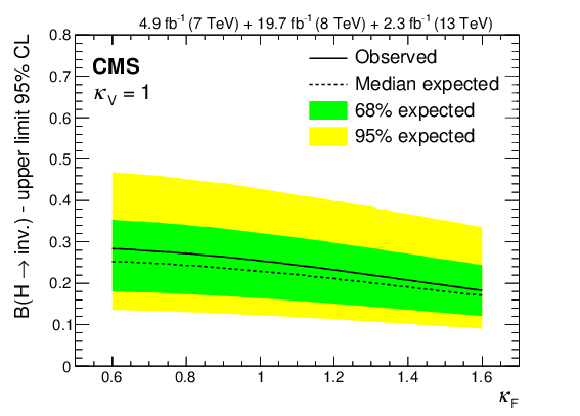
png pdf |
Figure 11-b:
Observed and expected 95% CL upper limit on ${\mathcal {B}(\mathrm{ H } \to \text {inv})}$ assuming a Higgs boson with a mass of 125 GeV whose production cross sections are scaled, relative to their SM values as a function of $\kappa _{F}$, fixing $\kappa _{V}= $ 1. |

png pdf |
Figure 12:
Observed 95% CL upper limits on ${\mathcal {B}(\mathrm{ H } \to \text {inv})}$ assuming a Higgs boson with a mass of 125 GeV whose production cross sections are scaled, relative to their SM values, by $\mu _{\mathrm{g} \mathrm{g} \mathrm{ H } }$ and $\mu _{\mathrm{ q } \mathrm{ q } \mathrm{ H },\mathrm {V}\mathrm{ H } }$. The SM (yellow diamond) is attained for $\mu _{\mathrm{g} \mathrm{g} \mathrm{ H } }=\mu _{\mathrm{ q } \mathrm{ q } \mathrm{ H },\mathrm {V}\mathrm{ H } }=$ 1. |
| Tables | |

png pdf |
Table 1:
Summary of the expected composition of production modes of a Higgs boson with a mass of 125 GeV in each analysis included in the combination. The relative contributions assume SM production cross sections. |

png pdf |
Table 2:
Event selections for the VBF invisible Higgs boson decay search at 8 and 13 TeV. |
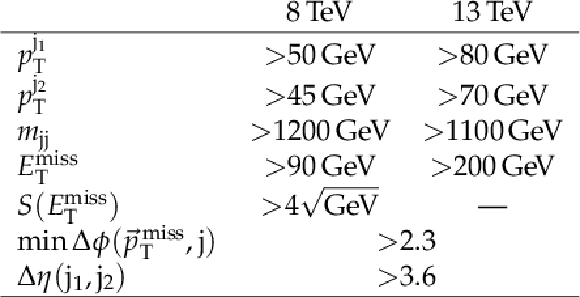
png pdf |
Table 3:
Post-fit yields for the control regions and signal region of the VBF analysis using the 13 TeV data set. The fit ignores the constraints due to the data in the signal region. For the W and Z processes, jet production through QCD or EW vertices are listed as separate entries. The signal yields shown assume SM ggH and qqH production rates for a Higgs boson with a mass of 125 GeV, decaying to invisible particles with $ {\mathcal {B}(\mathrm{ H } \to \text {inv})} =$ 100%. |

png pdf |
Table 4:
Event selections for the $ {{\mathrm{ Z } } (\ell ^+\ell ^-)}$ invisible Higgs boson search using the 7, 8, and 13 TeV data sets. The $ {{\Delta \phi ( \vec{p}_{\mathrm {T}}^{\text {miss}},\mathrm {j})}}$ requirement is applied only in the 1-jet category. |

png pdf |
Table 5:
Predicted signal and background yields and observed number of events after full selection in the 13 TeV $ {{\mathrm{ Z } } (\ell ^+\ell ^-)}$-tagged analysis. The numbers are given for the 0-jet and 1-jet categories, separately for the $ {\mathrm{ e }^{+} \mathrm{ e }^{-} } $ and $ {\mu^{+} \mu^{-} } $ final states. The uncertainties include statistical and systematic components. The signal prediction assumes a SM ZH production rate for a Higgs boson with the mass of 125 GeV and a 100% branching fraction to invisible particles. |

png pdf |
Table 6:
Event selections for the $ {\textrm {V}(\mathrm {jj})}$ and monojet invisible Higgs boson decay searches using the 8 and 13 TeV data sets. The requirements on $ {p_{\mathrm {T}}} ^{\mathrm {j}}$ and $ {| \eta | }^{\mathrm {j}}$ refer to the highest ${p_{\mathrm {T}}}$ (large-radius) jet in the monojet ($ {\textrm {V}(\mathrm {jj})}$) events. The 8 TeV analysis uses only the leading jet in the definition of $ \text{min} \Delta \phi ( \vec{p}_{\mathrm {T}}^{\text {miss}},\mathrm {j})$. In the 8 TeV number of jets $\mathrm {N}_{\mathrm {j}}$ selection, events with one additional jet are allowed if this additional jet falls within $\Delta \phi $ of the leading jet as described in the text. |

png pdf |
Table 7:
Dominant sources of systematic uncertainties and their impact on the fitted value of ${\mathcal {B}(\mathrm{ H } \to \text {inv})}$ in the VBF analysis at 13 TeV. The systematic uncertainties are split into common uncertainties and those specific to the signal model. The total systematic uncertainty, the total uncertainty fixing all constrained nuisance parameters to their maximum likelihood estimates (statistical only), and the total uncertainty are also given. |

png pdf |
Table 8:
Dominant sources of systematic uncertainties and their impact on the fitted value of ${\mathcal {B}(\mathrm{ H } \to \text {inv})}$ in the $ {{\mathrm{ Z } } (\ell ^+\ell ^-)}$ analysis at 13 TeV. The systematic uncertainties are split into common uncertainties and those specific to the signal model. The total systematic uncertainty, the total uncertainty fixing all constrained nuisance parameters to their maximum likelihood estimates (statistical only), and the total uncertainty are also given. |

png pdf |
Table 9:
Dominant sources of systematic uncertainties and their impact on the fitted value of ${\mathcal {B}(\mathrm{ H } \to \text {inv})}$ in the ${\textrm {V}(\mathrm {jj})} $ analysis at 13 TeV. The systematic uncertainties are split into common uncertainties and those specific to the signal model. The total systematic uncertainty, the total uncertainty fixing all constrained nuisance parameters to their maximum likelihood estimates (statistical only), and the total uncertainty are also given. |
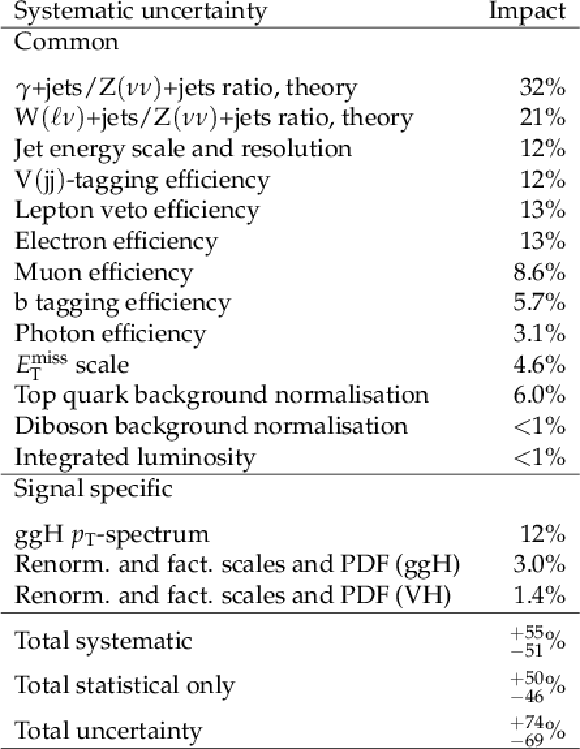
png pdf |
Table 10:
Dominant sources of systematic uncertainties and their impact on the fitted value of ${\mathcal {B}(\mathrm{ H } \to \text {inv})}$ in the monojet analysis at 13 TeV. The systematic uncertainties are split into common uncertainties and those specific to the signal model. The total systematic uncertainty, the total uncertainty fixing all constrained nuisance parameters to their maximum likelihood estimates (statistical only), and the total uncertainty are also given. |
| Summary |
| A combination of searches for a Higgs boson decaying to invisible particles using proton-proton collision data collected during 2011, 2012, and 2015, at centre-of-mass energies of 7, 8, and 13 TeV, respectively, is presented. The combination includes searches targeting Higgs boson production in the ZH mode, in which a Z boson decays to $\ell^{+}\ell^{-}$ or $\mathrm{ b \bar{b} }$, and the qqH mode, which is the most sensitive channel. The combination also includes the first searches at CMS targeting VH production, in which the vector boson decays hadronically, and the ggH mode in which the Higgs boson is produced in association with jets. No significant deviations from the SM predictions are observed and upper limits are placed on the branching fraction for the Higgs boson decay to invisible particles. The combination of all searches yields an observed (expected) upper limit on ${\mathcal{B}(\mathrm{ H }\to \text{inv})}$ of 0.24 (0.23) at the 95% confidence level, assuming SM production of the Higgs boson. The combined 90% confidence level limit of $\mathcal{B}(\mathrm{ H }\to \text{inv}) < $ 0.20 has been interpreted in Higgs-portal models and constraints are placed on the spin-independent DM-nucleon interaction cross section. These limits provide stronger constraints than those from direct detection experiments for DM masses below roughly 20 (5) GeV, assuming a fermion (scalar) DM particle, within the context of Higgs-portal models. |
| References | ||||
| 1 | ATLAS Collaboration | Observation of a new particle in the search for the Standard Model Higgs boson with the ATLAS detector at the LHC | PLB 716 (2012) 1 | 1207.7214 |
| 2 | CMS Collaboration | Observation of a new boson at a mass of 125 GeV with the CMS experiment at the LHC | PLB 716 (2012) 30 | CMS-HIG-12-028 1207.7235 |
| 3 | CMS Collaboration | Observation of a new boson with mass near 125 GeV in pp collisions at $ \sqrt{s} = $ 7 and 8 TeV | JHEP 06 (2013) 081 | CMS-HIG-12-036 1303.4571 |
| 4 | ATLAS and CMS Collaboration | Measurements of the Higgs boson production and decay rates and constraints on its couplings from a combined ATLAS and CMS analysis of the LHC pp collision data at $ \sqrt{s}= $ 7 and 8 TeV | JHEP 08 (2016) 045 | 1606.02266 |
| 5 | G. Belanger et al. | The MSSM invisible Higgs in the light of dark matter and g-2 | PLB 519 (2001) 93 | hep-ph/0106275 |
| 6 | G. F. Giudice, R. Rattazzi, and J. D. Wells | Graviscalars from higher-dimensional metrics and curvature-Higgs mixing | NPB 595 (2001) 250 | hep-ph/0002178 |
| 7 | D. Dominici and J. F. Gunion | Invisible Higgs decays from Higgs-graviscalar mixing | PRD 80 (2009) 115006 | 0902.1512 |
| 8 | R. E. Shrock and M. Suzuki | Invisible decays of Higgs bosons | Phy. Lett. B 110 (1982) 250 | |
| 9 | S. Baek, P. Ko, W.-I. Park, and E. Senaha | Higgs portal vector dark matter: revisited | JHEP 05 (2013) 036 | 1212.2131 |
| 10 | A. Djouadi, O. Lebedev, Y. Mambrini, and J. Quevillon | Implications of LHC searches for Higgs--portal dark matter | PLB 709 (2012) 65 | 1112.3299 |
| 11 | A. Djouadi, A. Falkowski, Y. Mambrini, and J. Quevillon | Direct detection of Higgs-portal dark matter at the LHC | EPJC 73 (2013) 2455 | 1205.3169 |
| 12 | A. Beniwal et al. | Combined analysis of effective Higgs portal dark matter models | PRD 93 (2016) 115016 | 1512.06458 |
| 13 | G. Servant and S. Tulin | Baryogenesis and Dark Matter through a Higgs Asymmetry | PRL 111 (2013) 151601 | 1304.3464 |
| 14 | T. Cohen, D. E. Morrissey, and A. Pierce | Electroweak baryogenesis and Higgs signatures | PRD 86 (2012) 013009 | 1203.2924 |
| 15 | ATLAS Collaboration | Search for Invisible Decays of a Higgs Boson Produced in Association with a Z Boson in ATLAS | PRL 112 (2014) 201802 | 1402.3244 |
| 16 | ATLAS Collaboration | Search for invisible decays of the Higgs boson produced in association with a hadronically decaying vector boson in pp collisions at $ \sqrt{s} = $ 8 TeV with the ATLAS detector | EPJC 75 (2015) 337 | 1504.04324 |
| 17 | CMS Collaboration | Search for invisible decays of Higgs bosons in the vector boson fusion and associated ZH production modes | EPJC 74 (2014) 2980 | CMS-HIG-13-030 1404.1344 |
| 18 | ATLAS Collaboration | Search for invisible decays of a Higgs boson using vector-boson fusion in pp collisions at $ \sqrt{s} = $ 8 TeV with the ATLAS detector | JHEP 01 (2016) 172 | 1508.07869 |
| 19 | ATLAS Collaboration | Constraints on new phenomena via Higgs boson couplings and invisible decays with the ATLAS detector | JHEP 11 (2015) 206 | 1509.00672 |
| 20 | ATLAS Collaboration | Search for new phenomena in final states with an energetic jet and large missing transverse momentum in pp collisions at $ \sqrt{s} = $ 8 TeV with the ATLAS detector | EPJC 75 (2015) 299 | 1502.01518 |
| 21 | CMS Collaboration | The CMS experiment at the CERN LHC | JINST 3 (2008) S08004 | CMS-00-001 |
| 22 | CMS Collaboration | Particle-flow event reconstruction in CMS and performance for jets, taus, and MET | CMS-PAS-PFT-09-001 | |
| 23 | CMS Collaboration | Commissioning of the Particle-flow event reconstruction with the first LHC collisions recorded in the CMS detector | CMS-PAS-PFT-10-001 | |
| 24 | M. Cacciari, G. P. Salam, and G. Soyez | The anti-$ k_t $ jet clustering algorithm | JHEP 04 (2008) 063 | 0802.1189 |
| 25 | CMS Collaboration | A Cambridge-Aachen (C-A) based jet algorithm for boosted top-jet tagging | CDS | |
| 26 | CMS Collaboration | Identification of b quark jets with the CMS experiment | JINST 8 (2013) | CMS-BTV-12-001 1211.4462 |
| 27 | CMS Collaboration | Performance of b tagging at $ \sqrt{s} = $ 8 TeV in multijet, ttbar and boosted topology events | CMS-PAS-BTV-13-001 | CMS-PAS-BTV-13-001 |
| 28 | CMS Collaboration | Identification of b quark jets at the CMS Experiment in the LHC Run 2 | CMS-PAS-BTV-15-001 | CMS-PAS-BTV-15-001 |
| 29 | M. Cacciari, G. P. Salam, and G. Soyez | FastJet user manual | EPJC 72 (2012) 1896 | 1111.6097 |
| 30 | CMS Collaboration | Jet energy scale and resolution in the CMS experiment in pp collisions at 8 TeV | Submitted to JINST | CMS-JME-13-004 1607.03663 |
| 31 | CMS Collaboration | Determination of jet energy calibration and transverse momentum resolution in CMS | JINST 6 (2011) P11002 | CMS-JME-10-011 1107.4277 |
| 32 | CMS Collaboration | Performance of electron reconstruction and selection with the CMS detector in proton-proton collisions at $ \sqrt{s} = $ 8 TeV | JINST 10 (2015) P06005 | CMS-EGM-13-001 1502.02701 |
| 33 | CMS Collaboration | Performance of photon reconstruction and identification with the CMS detector in proton-proton collisions at $ \sqrt{s} = $ 8 TeV | JINST 10 (2015) P08010 | CMS-EGM-14-001 1502.02702 |
| 34 | CMS Collaboration | Performance of cms muon reconstruction in pp collision events at $ \sqrt{s} = $ 7 tev | JINST 7 (2012) P10002 | CMS-MUO-10-004 1206.4071 |
| 35 | M. Cacciari and G. P. Salam | Pileup subtraction using jet areas | PLB 659 (2008) 119 | 0707.1378 |
| 36 | CMS Collaboration | Reconstruction and identification of $ \tau $ lepton decays to hadrons and $ \nu_\tau $ at CMS | JINST 11 (2016) P01019 | CMS-TAU-14-001 1510.07488 |
| 37 | CMS Collaboration | The performance of the CMS muon detector in proton-proton collisions at $ \sqrt{s} = $ 7 TeV at the LHC | JINST 8 (2013) P11002 | CMS-MUO-11-001 1306.6905 |
| 38 | CMS Collaboration | Absolute calibration of the luminosity measurement at CMS: winter 2012 update | CDS | |
| 39 | CMS Collaboration | CMS luminosity based on pixel cluster counting - summer 2013 update | CMS-PAS-LUM-13-001 | CMS-PAS-LUM-13-001 |
| 40 | CMS Collaboration | CMS luminosity measurement for the 2015 data taking period | CMS-PAS-LUM-15-001 | CMS-PAS-LUM-15-001 |
| 41 | S. Alioli, P. Nason, C. Oleari, and E. Re | A general framework for implementing NLO calculations in shower Monte Carlo programs: the $ POWHEG $ BOX | JHEP 06 (2010) 043 | 1002.2581 |
| 42 | P. Nason and C. Oleari | NLO Higgs boson production via vector-boson fusion matched with shower in POWHEG | JHEP 02 (2010) 037 | 0911.5299 |
| 43 | S. Alioli, P. Nason, C. Oleari, and E. Re | NLO Higgs boson production via gluon fusion matched with shower in POWHEG | JHEP 04 (2009) 002 | 0812.0578 |
| 44 | T. Sjostrand, S. Mrenna, and P. Z. Skands | PYTHIA 6.4 physics and manual | JHEP 05 (2006) 026 | hep-ph/0603175 |
| 45 | T. Sjostrand, S. Mrenna, and P. Z. Skands | A brief introduction to PYTHIA 8.1 | CPC 178 (2008) 852 | 0710.3820 |
| 46 | C. Anastasiou et al. | Higgs boson gluon--fusion production at threshold in N$ ^3 $LO QCD | PLB 737 (2014) 325 | 1403.4616 |
| 47 | LHC Higgs Cross Section Working Group | Handbook of LHC Higgs cross sections: 3. Higgs properties | 1307.1347 | |
| 48 | D. de Florian, G. Ferrera, M. Grazzini, and D. Tommasini | Higgs boson production at the LHC: transverse momentum resummation effects in the $ \mathrm{H}\rightarrow \gamma\gamma $, $ \mathrm{H}\rightarrow WW \rightarrow l\nu l\nu $ and $ \mathrm{H}\rightarrow ZZ\rightarrow 4l $ decay modes | JHEP 06 (2012) 132 | 1203.6321 |
| 49 | M. Grazzini and H. Sargsyan | Heavy-quark mass effects in Higgs boson production at the LHC | JHEP 09 (2013) 129 | 1306.4581 |
| 50 | ATLAS and CMS Collaboration | Combined Measurement of the Higgs Boson Mass in pp collisions at $ \sqrt{s} = $ 7 and 8 TeV with the ATLAS and CMS Experiments | PRL 114 (2015) 191803 | 1503.07589 |
| 51 | LHC Higgs Cross Section Working Group | Handbook of LHC Higgs Cross Sections: 4. Deciphering the Nature of the Higgs Sector | 1610.07922 | |
| 52 | J. Alwall et al. | MadGraph 5: going beyond | JHEP 06 (2011) 128 | 1106.0522 |
| 53 | J. Alwall et al. | The automated computation of tree-level and next-to-leading order differential cross sections, and their matching to parton shower simulations | JHEP 07 (2014) 079 | 1405.0301 |
| 54 | S. Alioli, P. Nason, C. Oleari, and E. Re | NLO single-top production matched with shower in POWHEG: s- and t-channel contributions | JHEP 09 (2009) 111 | 0907.4076 |
| 55 | J. Pumplin et al. | New Generation of Parton Distributions with Uncertainties from Global QCD Analysis | JHEP 07 (2002) 012 | hep-ph/0201195 |
| 56 | R. D. Ball et al. | Impact of heavy quark masses on parton distributions and LHC phenomenology | NPB 849 (2011) 296 | 1101.1300 |
| 57 | CMS Collaboration | Study of the underlying event at forward rapidity in pp collisions at $ \sqrt{s} = $ 0.9, 2.76, and 7 TeV | JHEP 04 (2013) 072 | CMS-FWD-11-003 1302.2394 |
| 58 | CMS Collaboration | Event generator tunes obtained from underlying event and multiparton scattering measurements | EPJC 76 (2016) 155 | CMS-GEN-14-001 1512.00815 |
| 59 | GEANT4 Collaboration | Geant4---a simulation toolkit | NIMA 506 (2003) 250 | |
| 60 | CMS Collaboration | Data Parking and Data Scouting at the CMS Experiment | CDS | |
| 61 | CMS Collaboration | Search for dark matter in proton-proton collisions at 8 TeV with missing transverse momentum and vector boson tagged jets | Submitted to JHEP | CMS-EXO-12-055 1607.05764 |
| 62 | CMS Collaboration | Performance of the CMS missing transverse momentum reconstruction in pp data at $ \sqrt{s} = $ 8 TeV | JINST 10 (2015) P02006 | CMS-JME-13-003 1411.0511 |
| 63 | CMS Collaboration | Measurement of the $ \mathrm{ p }\mathrm{ p } \to \mathrm{ Z }\mathrm{ Z } $ production cross section and constraints on anomalous triple gauge couplings in four-lepton final states at $ \sqrt s= $ 8 TeV | PLB 740 (2015) 250 | CMS-SMP-13-005 1406.0113 |
| 64 | CMS Collaboration | Measurement of the $ {{\mathrm{W} }^{+} }\mathrm{W}^{-} $ cross section in pp collisions at $ \sqrt{s} = $ 8 TeV and limits on anomalous gauge couplings | EPJC 76 (2016) 401 | CMS-SMP-14-016 1507.03268 |
| 65 | CMS Collaboration | Measurement of $ \mathrm{ W^{+} }\mathrm{ W^{-} } $ and ZZ production cross sections in pp collisions at $ \sqrt{s} = $ 8 TeV | PLB 721 (2013) 190 | CMS-SMP-12-024 1301.4698 |
| 66 | CMS Collaboration | Measurement of the ZZ production cross section and $ \mathrm{ Z } \to \ell^+ \ell^- \ell^{\prime +} \ell^{\prime -} $ branching fraction in pp collisions at $ \sqrt{s} = $ 13 TeV | Submitted to: PLB | CMS-SMP-16-001 1607.08834 |
| 67 | CMS Collaboration | Measurement of the WZ production cross section in pp collisions at $ \sqrt{s} = $ 13 TeV | Submitted to: PLB | CMS-SMP-16-002 1607.06943 |
| 68 | CMS Collaboration | Measurements of the $ \mathrm{ t \bar{t} } $ production cross section in lepton+jets final states in pp collisions at 8 TeV and ratio of 8 to 7 TeV cross sections | Submitted to EPJC | CMS-TOP-12-006 1602.09024 |
| 69 | CMS Collaboration | Measurement of the t-channel single-top-quark production cross section and of the $ V_{\textrm{tb}} $ CKM matrix element in pp collisions at $ \sqrt{s} = $ 8 TeV | JHEP 06 (2014) 090 | CMS-TOP-12-038 1403.7366 |
| 70 | CMS Collaboration | Measurement of the Top Quark Pair Production Cross Section in Proton-Proton Collisions at $ \sqrt{s} = $ 13 TeV | PRL 116 (2016) 052002 | CMS-TOP-15-003 1510.05302 |
| 71 | K. Arnold et al. | VBFNLO: A parton level Monte Carlo for processes with electroweak bosons -- Manual for Version 2.7.0 | 1107.4038 | |
| 72 | J. Baglio et al. | Release Note -- VBFNLO 2.7.0 | 1404.3940 | |
| 73 | J. M. Campbell, R. K. Ellis, and C. Williams | Vector boson pair production at the LHC | JHEP 07 (2011) 018 | 1105.0020 |
| 74 | J. Butterworth et al. | PDF4LHC recommendations for LHC Run II | JPG 43 (2016) 023001 | 1510.03865 |
| 75 | J. Thaler and K. Van Tilburg | Identifying boosted objects with $ N $-subjettiness | JHEP 03 (2011) 015 | 1011.2268 |
| 76 | J. Thaler and K. Van Tilburg | Maximizing boosted top identification by minimizing N-subjettiness | JHEP 02 (2012) 093 | 1108.2701 |
| 77 | S. D. Ellis, C. K. Vermilion, and J. R. Walsh | Recombination algorithms and jet substructure: Pruning as a tool for heavy particle searches | PRD 81 (2010) 094023 | 0912.0033 |
| 78 | S. Ask et al. | Using $ \gamma $+jets production to calibrate the standard model $ z(\to \nu\nu) $+jets background to new physics processes at the LHC | JHEP 10 (2011) 058 | 1107.2803 |
| 79 | J. H. Kuhn, A. Kulesza, S. Pozzorini, and M. Schulze | Electroweak corrections to hadronic photon production at large transverse momenta | JHEP 03 (2006) 059 | hep-ph/0508253 |
| 80 | S. Kallweit et al. | NLO electroweak automation and precise predictions for W+multijet production at the LHC | JHEP 04 (2015) 012 | 1412.5157 |
| 81 | S. Kallweit et al. | NLO QCD+EW automation and precise predictions for V+multijet production | in 50th Rencontres de Moriond on QCD and High Energy Interactions La Thuile, Italy, March 21-28, 2015 2015 | 1505.05704 |
| 82 | S. Kallweit et al. | NLO QCD+EW predictions for V+jets including off-shell vector-boson decays and multijet merging | JHEP 04 (2016) 021 | 1511.08692 |
| 83 | NNPDF Collaboration | Parton distributions for the LHC run II | JHEP 04 (2015) 040 | 1410.8849 |
| 84 | T. Junk | Confidence level computation for combining searches with small statistics | NIMA 434 (1999) 435 | hep-ex/9902006 |
| 85 | A. L. Read | Presentation of search results: the $ CL_s $ technique | JPG 28 (2002) 2693 | |
| 86 | G. Cowan, K. Cranmer, E. Gross, and O. Vitells | Asymptotic formulae for likelihood-based tests of new physics | EPJC 71 (2011) 1554 | 1007.1727 |
| 87 | ATLAS and CMS Collaborations, LHC Higgs Combination Group | Procedure for the LHC higgs boson search combination in Summer 2011 | ATL-PHYS-PUB-2011-11, CMS NOTE 2011/005 | |
| 88 | CMS Collaboration | Search for the standard model Higgs boson produced in association with a W or a Z boson and decaying to bottom quarks | PRD 89 (2014) 012003 | CMS-HIG-13-012 1310.3687 |
| 89 | K. Hamilton, P. Nason, and G. Zanderighi | MINLO: multi-scale improved NLO | JHEP 10 (2012) 155 | 1206.3572 |
| 90 | S. Frixione and B. R. Webber | Matching NLO QCD computations and parton shower simulations | JHEP 06 (2002) 029 | hep-ph/0204244 |
| 91 | M. Bahr et al. | Herwig++ physics and manual | EPJC 58 (2008) 639 | 0803.0883 |
| 92 | S. Catani, D. de Florian, M. Grazzini, and P. Nason | Soft-gluon resummation for Higgs boson production at hadron colliders | JHEP 07 (2003) 028 | hep-ph/0306211 |
| 93 | R. D. Young and A. W. Thomas | Octet baryon masses and sigma terms from an su(3) chiral extrapolation | PRD 81 (2010) 014503 | |
| 94 | MILC Collaboration | Strange Quark Condensate in the Nucleon in 2+1 Flavor QCD | PRL 103 (2009) 122002 | 0905.2432 |
| 95 | LUX Collaboration | Results from a search for dark matter in the complete LUX exposure | 1608.07648 | |
| 96 | PandaX-II Collaboration | Dark Matter Results from First 98.7-day Data of PandaX-II Experiment | PRL 117 (2016) 121303 | 1607.07400 |
| 97 | SuperCDMS Collaboration | New results from the search for low-mass weakly interacting massive particles with the cdms low ionization threshold experiment | PRL 116 (2016) 071301 | |

|
Compact Muon Solenoid LHC, CERN |

|

|

|

|

|

|